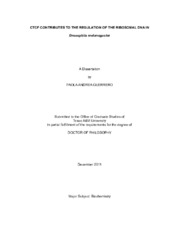| dc.description.abstract | The 35S rDNA gene clusters on the X and Y chromosomes of Drosophila melanogaster are repeats of approximately 150 to 225 copies. Each are transcribed as a single unit by RNA Polymerase I and modified into the 18S, 5.8S, 2S and 28S ribosomal rRNAs. Reduction in the array copy number results in a bobbed phenotype, characterized by truncated bristles and herniations of abdominal cuticle, due to a decrease in protein production. In some copies within the arrays, R1 and R2 retrotransposable elements are inserted in a conserved region of the 28S gene which represses the transcription of a functional rRNA. Inserted arrays are transcribed at very low levels, but it is not clear how they are identified for repression. Similarly, a subset of uninserted arrays are silenced, and the epigenetic mechanism controlling how this decision is made it is also unknown. The CCCTC binding factor (CTCF) is a boundary element binding protein and a transcriptional regulator found in the nucleolus of differentiated mammalian cells, whose localization requires poly (ADP-ribosyl)ation. We investigated whether CTCF might be involved in the regulation of rDNA expression in Drosophila. Our data show that CTCF is found at the nucleolus of both polytene and diploid nuclei, and we have identified binding sites in the 28S gene, R1 and R2 elements by a bioinformatic approach. ChIP data indicate that CTCF binds only to the site in the R1 retrotransposon. Reduction of CTCF or members of the poly(ADP-ribosyl)ation pathway by RNAi in S2 cells causes an increase in the amount of 35S rDNA gene, R1, and R2 transcripts. In flies, CTCF and PARG mutant alleles show disrupted nucleoli and increased rRNA transcripts. Mutant alleles of CTCF suppress variegation of a P-element inserted in a 35S rDNA array, but not of elements inserted elsewhere in the genome. Consistent with a role for CTCF in rRNA regulation, we found that during oogenesis CTCF is recruited to the nucleolus of nurse cells at early stages when the demand of ribosomes is low and it leaves this compartment in later stages when the cell increases rRNA production. We conclude from these studies that CTCF acts as a regulation of rDNA transcription by RNA polymerase I. | en |


